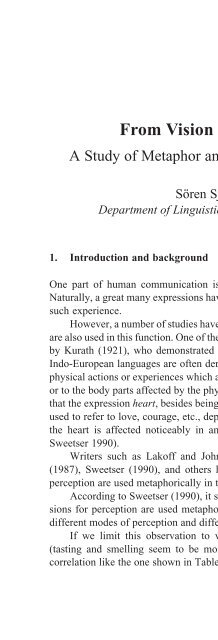Cognitive Semantics : Meaning and Cognition
Cognitive Semantics : Meaning and Cognition
Cognitive Semantics : Meaning and Cognition
Create successful ePaper yourself
Turn your PDF publications into a flip-book with our unique Google optimized e-Paper software.
SPACE AND TIME 143<br />
moment represented by the locus closest to the signer is earlier in time than the<br />
moment represented by the locus farther away.<br />
Even though the same configuration of loci can be used to express<br />
locative <strong>and</strong> temporal relations <strong>and</strong> both are static, there is thus a difference<br />
between the locative <strong>and</strong> the temporal use of space. In order to get the proper<br />
assignment of earlier <strong>and</strong> later in time, the receiver needs the dynamic notion<br />
of either the individual moving in time or time moving towards the individual<br />
in the canonical encounter. This difference between the two uses of space in<br />
sign language underlines the role of the cognitive difference between static<br />
situations <strong>and</strong> dynamic events in the description of temporal expressions, no<br />
matter whether these are semantically static or dynamic. 5<br />
4. Time <strong>and</strong> space: A metaphorical relation?<br />
The preceding sections give ample evidence that the linguistic devices used to<br />
express temporal relations <strong>and</strong> the linguistic devices used to express spatial<br />
relations are related in systematic ways. We cannot explain temporal expressions<br />
without reference to the perceiving human being in space, either as an<br />
individual moving along or as an individual “facing” time in the canonical<br />
encounter. But does that mean that temporal expressions are derived metaphorically<br />
from spatial expressions? The answer to this question depends on<br />
whether time <strong>and</strong> space constitute two different domains. In order to maintain<br />
that temporal expressions are metaphorically derived from spatial expressions,<br />
we need to claim that the two areas constitute different cognitive<br />
domains <strong>and</strong> that the domain of space is more basic than the domain of time. I<br />
am going to argue that time <strong>and</strong> space cannot be analyzed as separate domains,<br />
a fact that is reflected in many linguistic expressions. It seems, however, that<br />
both time <strong>and</strong> space are conceptualized at different levels, which makes it<br />
possible to talk about space-to-time metaphors as well as time-to-space metaphors<br />
at some levels.<br />
Langacker defines a domain as “[a] context for the characterization of a<br />
semantic unit” (1987: 147). Domains are cognitive entities, <strong>and</strong> a concept is<br />
defined in terms of the contexts or domains needed to characterize the concept.<br />
Domains are themselves concepts, <strong>and</strong> they are hierarchically organized<br />
in the sense that a concept is characterized by a number of domains that can<br />
themselves be characterized in terms of further domains. Basic domains are















